Dangerous times.
I have come to recognise that I feel the Spring coming, deep in the resonance of the Earth.
Apart from more generous days, where the light slowly fades, rather than snaps out, the signs on the ground are scarce.
Woodpeckers start their aerial, morning chess games.
A few buds, some bulbs push up their battery powered spears.
Some hopeful birds try to muster a rallying chorus in support of El Presidente, the Sun.
But the real mechanism is deep in the ground, in trees and roots, and how the sun dripfeeds its life into rocks and slopes, and our hearts.
Dangerous times.
We emerge, awkward but driven, to scrabble on our plots of garden, our heads congested with plans and schemes, and aghast at the enormity of the Task Ahead.
I spent Sunday in the garden, doing nothing well, but knowing that rain was finally due, so trying to have some beds ready for it.
Then I headed for the forest, to cut logs into planks for my next hut.
Late and already tired.
One pinched tight as I pushed it into the saw. Larch has a reputation for such tricks.
I stubbornly pushed harder, then realised I wasn't going to win, and tried to withdraw it, without turning it into a missile: another stunt of a tense log. Pulling it back dragged the riving knife into the saw blade, showering my face with metal.
I bled profusely!
I bound my head as tightly as I could and drove home, grateful for my friends who were there to tend to me.
There was a magic in that blood loss.
A tension is released.
Spring has Sprung
things that come to mind about healing the earth, and us on it. some are unfinished bits of writing, with enough sense, I think, in them to make them worth reading. recent ones are about finding a place on the land, and as one of its people.
Tuesday, 5 March 2013
Sunday, 3 March 2013
43>My garden
My garden has come of age.
Three years on and I am planting potatoes back where I first started.
I am quarrying into the precious contents of my first compost heap and spreading it on as many beds as I can. The bottom layers are still crunchy with half rotted bracken, which dominated this land early on.
I have an army of weeds ready to march at a moments notice to any bare earth.
But the sparkling jewel in the crown is the robin who has adopted the garden, and proclaims his dominion in sweet song from a fence post.
Three years on and I am planting potatoes back where I first started.
I am quarrying into the precious contents of my first compost heap and spreading it on as many beds as I can. The bottom layers are still crunchy with half rotted bracken, which dominated this land early on.
I have an army of weeds ready to march at a moments notice to any bare earth.
But the sparkling jewel in the crown is the robin who has adopted the garden, and proclaims his dominion in sweet song from a fence post.
Thursday, 7 February 2013
42>Hutmatters~3
Over that quiet panic of solstice the short days, I resolved to make huts to sell as flat panels.
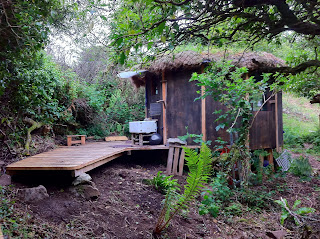
I got distracted by trying to work with a different shape & smaller size, but it dawned on me slowly that my most recent one was the model to copy: it was a Goldilocks Hut.
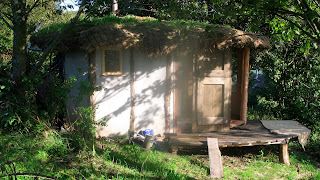
The size and proportions feel just right; to heat, & occupy without feeling crowded by my lifestyle, and its 12-sided shape seems future-perfect to embrace porches either for solar gain, an outdoor sink, to shed wet gear in, or to harbour dry firewood. Twelve sided structures can embrace hexagons, squares and triangles without rancour.

I have shared small roundhouses with no partitioning, apart from Inside, for living, cooking & sleeping, and an outdoor porch, for watery & messier activities, but try to recognise three equal spaces since then, for bed-space, clear space, and cooking.
A sink is a bit outdoor for me, though in my goldilocks hut, I can reach out to it from the kitchen in my socks if its raining.
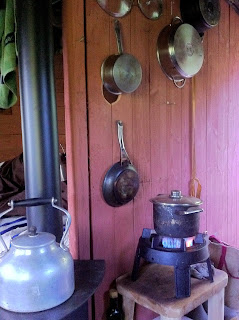
My personal washing is an indoor ritual of boiling a great kettle, a big basin & a blazing fire. Also, my son bought me a solar shower for Christmas which will add another dimension to the end of a sunny day.
The outdoor area is a key part of the living space. If it's a deck or a sheltered yard, I think it should be the same area as the indoor space. - Part of living in a small structure is to spend much more time in the open air.
A trip to the compost toilet is a great way to see the stars, or appreciate the cosy indoors after a venture into a wild night...
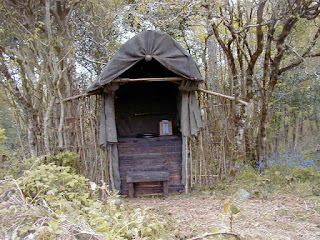
Our current houses are designed to withstand extreme human and weather onslaughts, much like wearing a flack jacket and a heavy overcoat in July.
They adopt a paranoid and hostile stance, always expecting the worst. Negative attitudes are infectious and quietly leak through the locks and alarms into their occupants.
Here I crouch in front of my laptop, like millions of others gazing at screens in their self-contained bunker homes, watching images of the world's worst mishaps.
We are what we occupy!
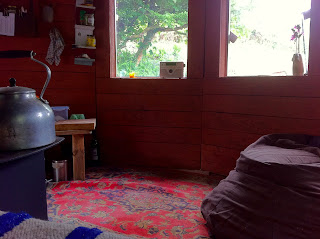
Noticing how pine cones, even long separated from their host tree, open in fine weather, I have long-wondered that we can't make walls that expand to allow balmy Spring air into our homes. Surely our houses should be able to open and celebrate the sun when it shines.
I am asking a lot...
Living structures that are deliberately impermanent/replaceable/repairable & affordable.
Somehow we need to divest them of accumulating value as "property".
That are modest in size, have an integrated outdoor space, and are not overly obtrusive. This is so they accord with their surroundings.
That can respond to the moods of the seasons and the weather. This too should help diminish our 'bunker' attitude to our shelters.
But it's all simple stuff!
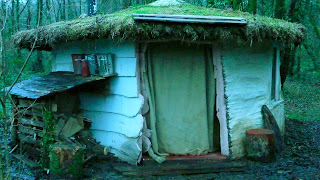
I got distracted by trying to work with a different shape & smaller size, but it dawned on me slowly that my most recent one was the model to copy: it was a Goldilocks Hut.
The size and proportions feel just right; to heat, & occupy without feeling crowded by my lifestyle, and its 12-sided shape seems future-perfect to embrace porches either for solar gain, an outdoor sink, to shed wet gear in, or to harbour dry firewood. Twelve sided structures can embrace hexagons, squares and triangles without rancour.
I have shared small roundhouses with no partitioning, apart from Inside, for living, cooking & sleeping, and an outdoor porch, for watery & messier activities, but try to recognise three equal spaces since then, for bed-space, clear space, and cooking.
A sink is a bit outdoor for me, though in my goldilocks hut, I can reach out to it from the kitchen in my socks if its raining.
My personal washing is an indoor ritual of boiling a great kettle, a big basin & a blazing fire. Also, my son bought me a solar shower for Christmas which will add another dimension to the end of a sunny day.
The outdoor area is a key part of the living space. If it's a deck or a sheltered yard, I think it should be the same area as the indoor space. - Part of living in a small structure is to spend much more time in the open air.
A trip to the compost toilet is a great way to see the stars, or appreciate the cosy indoors after a venture into a wild night...
Our current houses are designed to withstand extreme human and weather onslaughts, much like wearing a flack jacket and a heavy overcoat in July.
They adopt a paranoid and hostile stance, always expecting the worst. Negative attitudes are infectious and quietly leak through the locks and alarms into their occupants.
Here I crouch in front of my laptop, like millions of others gazing at screens in their self-contained bunker homes, watching images of the world's worst mishaps.
We are what we occupy!
Noticing how pine cones, even long separated from their host tree, open in fine weather, I have long-wondered that we can't make walls that expand to allow balmy Spring air into our homes. Surely our houses should be able to open and celebrate the sun when it shines.
I am asking a lot...
Living structures that are deliberately impermanent/replaceable/repairable & affordable.
Somehow we need to divest them of accumulating value as "property".
That are modest in size, have an integrated outdoor space, and are not overly obtrusive. This is so they accord with their surroundings.
That can respond to the moods of the seasons and the weather. This too should help diminish our 'bunker' attitude to our shelters.
But it's all simple stuff!
Monday, 28 January 2013
41>Hutmatters~2
As a young man, I spent most of my time outdoors one summer, working on farms, and sleeping outside or in barns. I felt trapped when I finally went home to four walls.
Ten years of living in small round huts have made conventional houses feel vast and slightly vacant, like unfilled swimming pools.
That's how they feel to me from the outside too : suburban grey space. Acres of dormancy and disconnection. As an angst-ridden teenager, I found the suburbs the scariest place of all.
We get used to our cages.
Planners despair as folk rescued from squalid terraces and rehoused in airy apartments plead to return.
Places become the holders of memory, of the pages of our unfolding roles, so of us.
There is a pioneering gene in us all, a homesteader instinct, that thrives on the making do, and making better.
This has to compete with an army of statutory building requirements, devised to ensure safe housing, but robbing all but the most ingenious or defiant of us of the will to try much more than a few shelves.
Something's Changed.
I think that when "property" prices where always spiralling upwards, they provided a double helix of hope to peoples' endeavours to aspire and acquire. Enough heady hope not to consider the hopelessness of anyone left behind in the future.
That's gone or is at least on Hold.
Somewhere to shelter feels like a pretty basic right to me.
It's just grown-up dens really. There's no authority in the world that has the right to take the joy out of life.
Maybe one way to restore the magic is to exclude the concept of permanence, of the dwelling being more than what it is at that moment in our lives, for our purpose. Like our bodies.
Look around you at the buildings. We are burying the Earth in our dead shells.
Sunday, 27 January 2013
40>Hutmatters ~1
Here I squat, huddled by my stove, the sleet dripping off the trees on my hut's roof. This hut doesn't really allow for much of this weather. I often go to bed early, and lie there, dreaming up newer, cosier designs.
Thermal Mass is what I need. What do I need? Thermal Mass.
Insulation just ain't it.
Of course, it's all totally obvious really: If you choose to spend life outdoors, you tend to like a Bit of Air in your living space anyway, and probably build your new eden based on warm and sunny days.
Since I started living in huts, doors have always been an optional extra. A curtain or two are so much more convenient. The eaves of a simple shelter need constant wadding to remain draught-proof as rats and birds love examining its possibilities. And so many functions of life happen outside the hut, that the only realistic insulated sanctuary in the end, is bed.
I lie here now, planning new huts. huts with no extra ventilation features. A cosy space that is easy to heat. huts that don't plummet to zero once the stove goes out.
Its cutting edge stuff.
I remember when my friend's house got central heating. I was about eight, and was used to huddling just outside the fireguard cage around our chortling gas fire. to bedrooms full of polar bears and to Anne, my big sister creeping in to steal my hotwater bottle for her own bed. to the wild jagged patterns of jack frost on the bathroom window.
Now automatic domestic heat is a cultural norm. Left unattended all day, the living space can remain warm and welcoming. Remote rooms need not feel made of ice.
Bath-times too had been major weekly events. The heating system had to be cajoled into producing the necessary hot water. Towels warmed.
The spontaneous shower and habitual cleanliness came as part of the great gift of the domestic central heating boiler.
I used to experience the roar of my brothers suburban heating system on visits to London, as part of that Greater Roar, of Heathrow, the M4 : the whole South-East as a great gas hob turned up full-blast.
I have seen that raw energy too, looking upriver from the peaceful moorings of Dale in Pembrokeshire, towards the Oil & Gas refineries in Milford Haven, as they shoot flames into the night sky, like Smaug guarding his horde.
Oil has changed our domestic geography just as radically as it has our civil space.
There's an epic task here, working out which bits of each we transform and which we work out how to fuel differently.
Cars and Houses.
Both are so embedded in how we behave and have come to value ourselves, that any change is seen as a threat to our Culture's core.
It is going to be fun.
Thermal Mass is what I need. What do I need? Thermal Mass.
Insulation just ain't it.
Of course, it's all totally obvious really: If you choose to spend life outdoors, you tend to like a Bit of Air in your living space anyway, and probably build your new eden based on warm and sunny days.
Since I started living in huts, doors have always been an optional extra. A curtain or two are so much more convenient. The eaves of a simple shelter need constant wadding to remain draught-proof as rats and birds love examining its possibilities. And so many functions of life happen outside the hut, that the only realistic insulated sanctuary in the end, is bed.
I lie here now, planning new huts. huts with no extra ventilation features. A cosy space that is easy to heat. huts that don't plummet to zero once the stove goes out.
Its cutting edge stuff.
I remember when my friend's house got central heating. I was about eight, and was used to huddling just outside the fireguard cage around our chortling gas fire. to bedrooms full of polar bears and to Anne, my big sister creeping in to steal my hotwater bottle for her own bed. to the wild jagged patterns of jack frost on the bathroom window.
Now automatic domestic heat is a cultural norm. Left unattended all day, the living space can remain warm and welcoming. Remote rooms need not feel made of ice.
Bath-times too had been major weekly events. The heating system had to be cajoled into producing the necessary hot water. Towels warmed.
The spontaneous shower and habitual cleanliness came as part of the great gift of the domestic central heating boiler.
I used to experience the roar of my brothers suburban heating system on visits to London, as part of that Greater Roar, of Heathrow, the M4 : the whole South-East as a great gas hob turned up full-blast.
I have seen that raw energy too, looking upriver from the peaceful moorings of Dale in Pembrokeshire, towards the Oil & Gas refineries in Milford Haven, as they shoot flames into the night sky, like Smaug guarding his horde.
Oil has changed our domestic geography just as radically as it has our civil space.
There's an epic task here, working out which bits of each we transform and which we work out how to fuel differently.
Cars and Houses.
Both are so embedded in how we behave and have come to value ourselves, that any change is seen as a threat to our Culture's core.
It is going to be fun.
Subscribe to:
Comments (Atom)